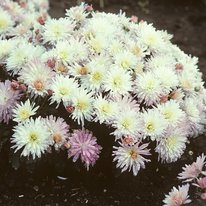Wave chrysanthemums form mounds with floral coverage nearly to the ground, giving the effect of snow drifts. With an average size of 12 inches tall by 24 inches wide, these mums remain shorter and spread wider than other growth habits.
University of Minnesota Wave Habit Chrysanthemum Varieties
Snowscape
- White with purple tips, 3 inch, semi-double flowers
- Semi-wave growth habit
- Early bloom period
- Plant grows up to 12"
- Released in 1996
Plant size measurements refer to first-year plants properly spaced and grown in full sun.
Bloom period represents average state-wide appearance of first blooms. Early: Starts blooming before September 1; Midseason: September 1-15; Late: After September 15.
Commercialization and licensing
These varieties are not protected by US Plant Patent or foreign plant breeders' rights, but nurseries propagating this variety can support the U of M breeding program through an agreement with the Minnesota Nursery Research Corporation (MNRC). The Minnesota Nursery Research Corporation (MNRC) is a non-profit horticultural organization that sponsors scientific research for the commercial growing industry. Since 1957, MNRC has collected voluntary payments from propagators of U of M ornamental and fruit introductions and contributed over $2.5 million to the U of M Department of Horticultural Science. Generous MNRC participants are dedicated to supporting research science and breeding efforts. They believe in the development of cold hardy, disease resistant, prolific and profitable future cultivars and varieties.
If you are a propagator and would like to support the future of the industry by participating in MNRC, please email Pat Bailey, MNRC President, at [email protected].


